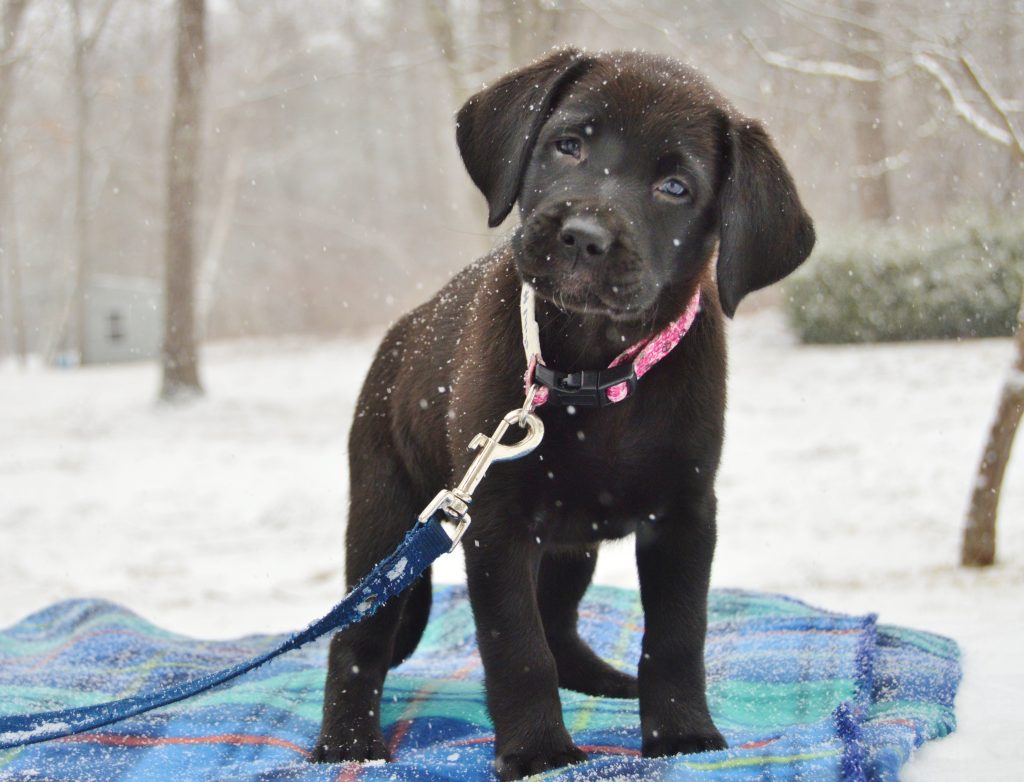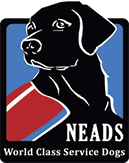Winter Fitness for your NEADS dog
Keeping your Service/Assistance Dog fit year round can be a struggle, especially for those who live in areas where winter weather is unpredictable or inhospitable. Extreme temperatures, ice and snow can limit outdoor time to bathroom-only breaks and leave little access for handlers with mobility challenges. But working dogs must be kept in prime condition at all times, including during the winter months. Weight control and daily exercise are important aspects of your dog’s health that cannot be overlooked. Luckily there are some creative ways to keep your dog moving even if throwing the ball in the backyard isn’t an option.
-Utilize a long hallway, basement or stairwell
Indoor exercise is typically not as effective as outdoor exercise at raising your dog’s heart rate, since the dog cannot run quite as far or as long when confined to a small area. But if you can find a space in your home that is at least 20 feet long (think hallway, two adjoining rooms, a basement or a non-slippery stairwell), then you can at least let the dog stretch his or her legs. Toss a soft toy or short rope for an interactive session of “Get It” down the length of your desired space. Be sure to bring the special toy out just for a short time and then put it away once you’re done so that the dog does not start to initiate play with you indoors all day long.
-Interactive snack toys
The next best thing to a physically tired dog is a mentally stimulated dog. Keeping your dog’s mind working keeps them thinking and engaged in a constructive outlet for their extra energy. Remember, your dog is used to learning new things, going new places and working for a living. If that creative outlet is suddenly shut off, your dog is likely to search out other ways to entertain himself (and it may not be in ways that you approve of.) Kong toys are probably the most widely known interactive dog snack toys on the market, but there are many different varieties out there. Look for something that is durable and made for tough chewers so that your dog is not put at risk of swallowing small plastic pieces. You can also make your own interactive game of seek and find by hiding a few kibbles from your dog’s meal in a muffin tin and placing tennis balls in all of the holes. Allow your dog to sniff out the treats and remove the tennis balls to reveal his reward. Just be sure to include all treats as part of your dog’s daily food ration.
-Train your dog to use a treadmill
A treadmill can be a great tool to use for structured indoor exercise. It keeps the dog focused on moving forward while achieving balanced aerobic exercise. This is a great option for dogs who don’t enjoy retrieving or owners who cannot physically walk their dogs. It’s important to introduce your dog to the treadmill slowly and not to ask them to run too fast or too long as they become accustomed to the new routine. Contact your NEADS trainer for more info. and guidelines.
-Find another venue
One of the perks of having a Service Dog is public access. If you don’t have an appropriate area to walk your dog at home, you can always make a trip to a local mall or other large building to walk a few laps indoors. Just remember to give your dog plenty of opportunities to eliminate outside before, during and after a lot of walking. Physical movement can speed up digestive systems and cause the need to “go” with little notice. (And of course the dog should always be dressed, on lead and under control while in public.) Another good opportunity for indoor exercise away from home is swimming. There are several indoor dog pools in Massachusetts. Maybe there is one near you?
A few final tips for judging whether outdoor play in cold weather is safe for your dog.
*Watch the temperature. In mild cold with no wind, (32°), a healthy dog can play outside for 30-60 minutes. In temperatures in the teens with heavy wind, the same dog may only be comfortable for 5-10 minutes. Watch your dog for signs of shivering, shallow breathing, muscle stiffness, weak pulse or lethargy.
*Keep an eye on your fence. A four foot fence can easily turn into a two foot fence after a snow storm. If you think that your dog can step or jump over your fence at any point it should not be considered a safely enclosed area any longer. If your dog is trained to an electronic fence, be sure the check it often to make sure the underground wire has not been severed by frost heaves or plow trucks. If this happens it is almost impossible to fix until the ground thaws in the spring, so be sure to have a backup option to keep your dog safe. Power outages can also cause radio collars to be ineffective.
*Avoid ice. The temperature may be right, the deck may be clear and the fence may be working, but if the yard where your dog is playing is icy they are then put at risk of slipping, falling and injuring themselves. If you cannot get out to the area where your dog is running to assess it, consider it unsafe for play until someone can check it
for you.
*Beware of chemical treatments on the ground. Ice melters, salt and other chemicals can cause burns in pads, irritation of the mouth and esophagus (when the dog licks its paws), and small dogs who are low to the ground may also have skin irritation in the stomach area. Additionally, ice-melt can make paws wet and more likely to get frostbitten. Car antifreeze comes in several forms. Ethylene Glycol is very poisonous and has a sweet taste that appeals to dogs. As little as 1-2 teaspoons can be lethal to a small animal. Snow ingestion should be monitored as it can include toxic contaminants such as antifreeze, de-icer and foreign objects.

